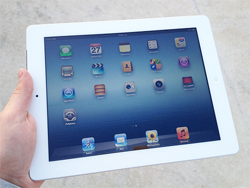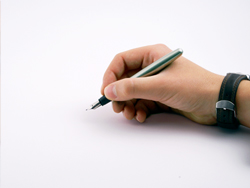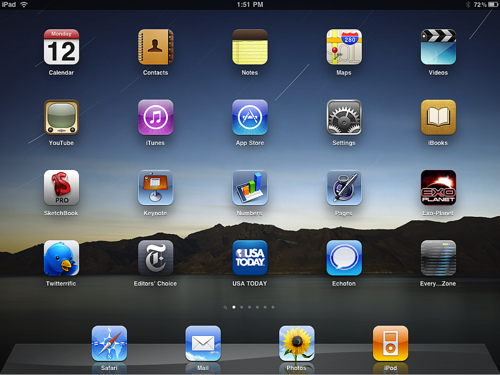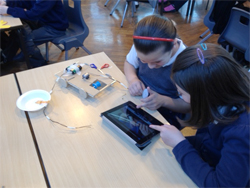
From a BYOD (Bring Your Own Device) programme to a 1:1 iPad initiative, there are a number of options available to schools when embracing new technology in the classroom. Consequently, it is becoming common for school leaders to purchase one device to trial in the classroom before making any real financial commitment.
As the iPad is currently the ‘class leader’ in education, there are many educators who have found themselves with an iPad to ‘see what it can do?’ The challenge is to demonstrate enhanced learning, so here are ten suggestions that may help:
Photo credit: http://www.flickr.com/photos/johnkarakatsanis

In recent literacy lessons I have been exploring the potential of the iPad to motivate children to write for different purposes. One ongoing target in our school is the emphasis on boys’ writing, so the theme here is going to be how one app has been used to encourage boys to write with confidence, in an appropriate style, and with a strong level of knowledge.
Having collaborated with David Andrews on the controllable vehicle project, it struck me how confident and knowledgable the children were in terms of speaking about their work, and this clarity and depth had a direct and hugely positive impact on the children’s writing. I wanted to see if using a popular gaming app would be able to make an impact on the writing of the children I teach.

Perhaps the biggest challenge for myself as an English and Media Studies teacher, and educators more broadly, is the constant fight against the steady decline of reading ability, and the capacity for reading for pleasure, that we find each year in our schools. Without wishing to sound like a jack-booted CBI spokesperson (who seem to exist only to reduce corporate taxes and demonise the state education system), there is undoubtedly a decline in reading that has a pervasive effect on our students and their life chances; affecting their capacity to read both functionally, and as equally importantly, to experience the imaginative delights that reading literature has to offer. I am sure many teachers could provide lots of anecdotal evidence of a decline in reading habits (by this, I must stress ‘traditional’ reading – web reading is in rude health in many aspects), alongside some hard statistical evidence.

Since I started blogging about iPads in education, I've been getting carried away with the positives that this handheld technology can bring to the classroom. However, there's been one major area of concern that I keep encountering during this 'iPad journey': the school's wireless network!
As ICT coordinator, one of my biggest headaches over the last year has been our wireless networking. The downsides are the notoriously unpredictable wireless technology and its performance, which can lead to high levels of frustration for both teachers and pupils. The wireless is going to be central, especially when there could be anything up to 30+ iPads and/or iPods that all need wireless access at the same time and all expecting a fast connection to the internet. A powerful wireless network is therefore essential to a successful implementation of handheld devices in the classroom.

I have yet to find the perfect digital portfolio app that I think I would use exclusively in a visual arts class. Some apps can be used as graphic portfolios or as beautiful sketchbooks, others are great at sharing. Not all of the apps available are great at all of these things. I have spent a heap of time trying to find one and would be more than happy for someone to send me the name of ones they are using successfully. Having said that, the following are apps that I would consider using as eportfolios:
Evernote: FREE
Evernote is an easy-to-use, free app that helps you remember everything across all of the devices you use. Stay organized, save your ideas and improve productivity. Evernote lets you take notes, capture photos, create to-do lists, record voice reminders--and makes these notes completely searchable, whether you are at home, at work, or on the go.

This blog post is going to examine how the iPad was used to improve the pedagogy of a Design & Technology project, and allow child initiated learning by motivating the children to discover new skills and knowledge through project based learning.
The ultimate aim of the controllable vehicle project, and use of the iPads, was to get the children to become more responsible for their own learning and not rely on the step by step instructions that I used to provide at the start of each lesson in previous years.

Students aren’t daunted by the iPad interface. They may take time to experiment and understand steps required to produce an outcome, but they will persevere. Having observed students at different stages of learning, across many subjects, it has become clear that students aren’t a barrier to learning with the iPad. If a process doesn’t work for a student, they will try something different. They collaborate with peers to produce quality work and will heed advice to move forward.
It compliments our wish as teachers that students should be more resilient in their learning, and I question why they are so prepared to persevere with the device? The answers given by students are telling.

ArtiKix - Full: £20.99
An engaging articulation app with flashcard and matching activities for children with speech sound delays. The highly requested group scoring feature is available for collecting scores in flashcards on up to 4 children at a time. A group of students can now collect data as they practice sounds in words and sentences with a speech-language pathologist, their parents, or independently.

It has been obvious to me for some time now that any learning that is based around use of an iPad should really not be hung on one particular app.
That it is about a flow of work, be it individual, or collaborative. Yes, there are some powerful productivity apps that will assist with note taking and organising oneself. There are also amazing apps with content, but actually – in an environment where students have access to iPads – we want them to be able to demonstrate their understanding and learning through the generation of their own content.
With that in mind, I’ve been thinking that there are two main tiers of creation based apps for the iPad. There are those that are compilers and those that are the creation tools, i.e. those tools that take all of the various elements that you have created and those that put all of those things in to a combined format.

If you want to enhance learning for students then use an iPad. There, I’ve said it. Colours to the mast and no doubt scrutiny abounds. Whenever I find an issue there is a solution. Whenever a question is posed, there is an answer – for students and staff.
It’s a tool – another weapon in an educator's arsenal. The iPad is not the answer, the be all and end all, the cure to educational woe. It will enhance learning when used appropriately, at the right time and for the right reason. The point is, the iPad provides opportunity that hasn’t existed in mainstream education.

A community-driven platform for showcasing the latest innovations and voices in schools
Pioneer House
North Road
Ellesmere Port
CH65 1AD
United Kingdom